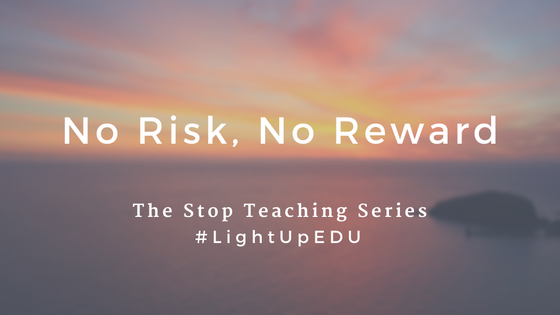Risks are things that educators have a hard time taking. Why? For one, when we discuss taking risks we are usually referring to our instruction – which we see as having a direct impact on student learning. By taking risks, we fear irreparable harm on a student’s acquisition of material.
I’d argue that the majority of what we are doing now in our classrooms needs to be discussed, if not completely redefined. We can’t afford not to take risks.
We can’t afford not to take risks. Click To TweetMany of our frameworks are still content heavy. They still focus on dates and terms and a linear progression of what someone else thinks learning should look like. Learning, and the pursuit of it, is a wildly personal adventure. Every student learns in different ways and yet much of what we do in our classrooms is catered to certain types of learners.
A lot of times taking a risk simply means adopting more of a student-centered learning model in your classroom. Giving up that control and ownership is not easy. Ultimately, you feel responsible for what your students learn, right? Free yourself from that responsibility and know that, if designed correctly, your facilitation of their learning will teach them way more than you simply teaching them. They learn skills, not just content.
Of course, taking risks requires a culture that promotes risk taking. I get it – you don’t want to buck the system if you’re going to be called on the carpet for it. If you’re living in a riskless culture, it’s time to start having those conversations. It’s not easy, it will be uncomfortable, and you will get weird looks. But, your students are worth it – learning will improve based on your willingness to take a risk. And, if it doesn’t, you’ve tried something new and learned from it; and it WILL continue to get better and more effective.
If you live in a risk-supportive culture, what’s stopping you? It’s time to stop teaching and start taking risks.
If you live in a risk-supportive culture, what’s stopping you? It’s time to stop teaching and start taking risks. Click To Tweet


This is important advice. I do think that teachers can use their PLCs to help create an environment that both promotes and protects risks. Teachers aren’t just out there on their own and have professional support and critique to help them not just take risks but assess their results.